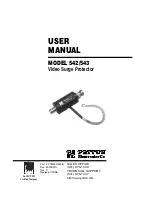
Evaluating Vacuum Pump Performance
The primary performance criteria cover three characteristics:
• Vacuum level that can be produced.
• Rate of air removal.
• Power required.
Somewhat less critical are temperature effects and certain
other characteristics. In general, the best pump for a specific
job is the one having the greatest pumping capacity at the
required vacuum level and operating within an acceptable
horsepower range.
Vacuum Level
- A pump's vacuum rating is the maximum
vacuum level for which it is recommended. The rating is
expressed in “Hg and is specified for either continuous or
intermittent duty cycles.
Most vacuum pumps can't come near the theoretical
maximum vacuum (29.92"Hg at sea level) because of internal
leakage. For a reciprocating piston pump the upper vacuum
limit may be 28 or 28.5"Hg, roughly 93 to 95 % of the
maximum theoretical value. Internal leakage and clearance
volume establish the highest vacuum a pump can produce.
For some pumps, this is also the vacuum rating. In other
types, however, heat dissipation is a problem. For these, the
maximum vacuum rating might be based on allowable
temperature rise. For example, good wear life for some rotary
vane pumps requires a maximum 180 F (82 C) rise in casing
temperature at the exhaust port. Vacuum ratings will be
based on this temperature rise. The vacuum rating listed for
a pump is based on operation at 29.92"Hg.
1
23
Evaluating Vacuum Pump Performance
The primary performance criteria cover three characteristics:
• Vacuum level that can be produced.
• Rate of air removal.
• Power required.
Somewhat less critical are temperature effects and certain
other characteristics. In general, the best pump for a specific
job is the one having the greatest pumping capacity at the
required vacuum level and operating within an acceptable
horsepower range.
Vacuum Level
- A pump's vacuum rating is the maximum
vacuum level for which it is recommended. The rating is
expressed in “Hg and is specified for either continuous or
intermittent duty cycles.
Most vacuum pumps can't come near the theoretical
maximum vacuum (29.92"Hg at sea level) because of internal
leakage. For a reciprocating piston pump the upper vacuum
limit may be 28 or 28.5"Hg, roughly 93 to 95 % of the
maximum theoretical value. Internal leakage and clearance
volume establish the highest vacuum a pump can produce.
For some pumps, this is also the vacuum rating. In other
types, however, heat dissipation is a problem. For these, the
maximum vacuum rating might be based on allowable
temperature rise. For example, good wear life for some rotary
vane pumps requires a maximum 180 F (82 C) rise in casing
temperature at the exhaust port. Vacuum ratings will be
based on this temperature rise. The vacuum rating listed for
a pump is based on operation at 29.92"Hg.
1
23
Evaluating Vacuum Pump Performance
The primary performance criteria cover three characteristics:
• Vacuum level that can be produced.
• Rate of air removal.
• Power required.
Somewhat less critical are temperature effects and certain
other characteristics. In general, the best pump for a specific
job is the one having the greatest pumping capacity at the
required vacuum level and operating within an acceptable
horsepower range.
Vacuum Level
- A pump's vacuum rating is the maximum
vacuum level for which it is recommended. The rating is
expressed in “Hg and is specified for either continuous or
intermittent duty cycles.
Most vacuum pumps can't come near the theoretical
maximum vacuum (29.92"Hg at sea level) because of internal
leakage. For a reciprocating piston pump the upper vacuum
limit may be 28 or 28.5"Hg, roughly 93 to 95 % of the
maximum theoretical value. Internal leakage and clearance
volume establish the highest vacuum a pump can produce.
For some pumps, this is also the vacuum rating. In other
types, however, heat dissipation is a problem. For these, the
maximum vacuum rating might be based on allowable
temperature rise. For example, good wear life for some rotary
vane pumps requires a maximum 180 F (82 C) rise in casing
temperature at the exhaust port. Vacuum ratings will be
based on this temperature rise. The vacuum rating listed for
a pump is based on operation at 29.92"Hg.
1
23
Evaluating Vacuum Pump Performance
The primary performance criteria cover three characteristics:
• Vacuum level that can be produced.
• Rate of air removal.
• Power required.
Somewhat less critical are temperature effects and certain
other characteristics. In general, the best pump for a specific
job is the one having the greatest pumping capacity at the
required vacuum level and operating within an acceptable
horsepower range.
Vacuum Level
- A pump's vacuum rating is the maximum
vacuum level for which it is recommended. The rating is
expressed in “Hg and is specified for either continuous or
intermittent duty cycles.
Most vacuum pumps can't come near the theoretical
maximum vacuum (29.92"Hg at sea level) because of internal
leakage. For a reciprocating piston pump the upper vacuum
limit may be 28 or 28.5"Hg, roughly 93 to 95 % of the
maximum theoretical value. Internal leakage and clearance
volume establish the highest vacuum a pump can produce.
For some pumps, this is also the vacuum rating. In other
types, however, heat dissipation is a problem. For these, the
maximum vacuum rating might be based on allowable
temperature rise. For example, good wear life for some rotary
vane pumps requires a maximum 180 F (82 C) rise in casing
temperature at the exhaust port. Vacuum ratings will be
based on this temperature rise. The vacuum rating listed for
a pump is based on operation at 29.92"Hg.
1
23
















































